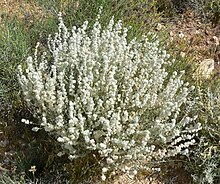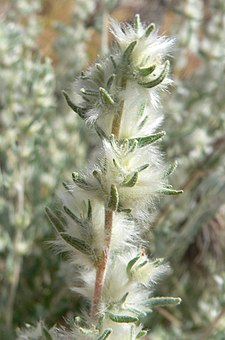Krascheninnikovia lanata
| Krascheninnikovia lanata | |
|---|---|

| |
| Scientific classification | |
| Kingdom: | Plantae |
| Clade: | Tracheophytes |
| Clade: | Angiosperms |
| Clade: | Eudicots |
| Order: | Caryophyllales |
| Family: | Amaranthaceae |
| Genus: | Krascheninnikovia |
| Species: | K. lanata
|
| Binomial name | |
| Krascheninnikovia lanata (Pursh) A.Meeuse & Smit
| |
| Synonyms | |
|
Ceratoides lanata (Pursh) J.T. Howell | |
Krascheninnikovia lanata is a species of flowering plant in the family
The
Distribution and habitat
Winterfat grows in a great variety of
Winterfat is a
.
Description
Krascheninnikovia lanata is a small shrub sending erect stem branches to heights between 0.5–1 metre (1.6–3.3 ft). It produces flat lance-shaped leaves up to 3 centimeters long. The stems and gray foliage are covered in woolly white hairs that age to a reddish color.[3] The woolly hairs start development in the late fall and gradually diminish through the winter season.[4]
The tops of the stem branches are occupied by plentiful spike
The pistillate flowers have smaller bracts and develop tiny white fruits. The silky hairs on the fruits allow for wind dispersal.
Cultivation
Krascheninnikovia lanata is cultivated in the specialty
Uses
This species is an important winter forage for grazing domestic and wild animals because it is evergreen, hence its common name.[1]
Cultivation
Winterfat is sometimes grown in xeriscape or native plant gardens for its striking whitish wool. It is especially valued for the fall and winter interest it provides in gardens. Small plants are easily transplanted.[4]
Native American use
Winter fat was a traditional
References
External links
- Jepson Manual Treatment - Krascheninnikovia lanata (Winterfat)
- USDA: Plants Profile of Krascheninnikovia lanata - with numerous Related Web Sites links.
- U.S. Forest Service: Krascheninnikovia lanata Ecology
- Native American Ethnobotany - 'Winterfat' - (University of Michigan - Dearborn)
- Krascheninnikovia lanata (Winterfat) - U.C. Photo gallery

